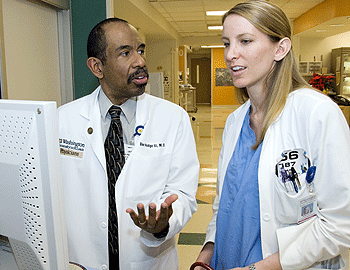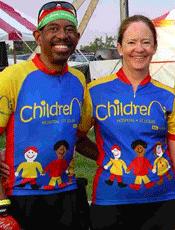For fun, Dee Hodge III, M.D., takes part in an annual 129-mile bike ride called the Death Ride in the Sierra Mountains near the California-Nevada border.
In addition to the distance, the premier cycling event held every July involves pedaling up five mountain passes between 5,500 feet and 8,730 feet and requires finishing within 14.5 hours. Hodge has attempted this feat 11 times and finished eight.

The endurance and determination that allow Hodge to compete in such events also well equips him to coordinate care of the 140 or so patients a day in one of the nation’s busiest pediatric emergency departments.
As associate director of clinic affairs emergency services at St. Louis Children’s Hospital, Hodge is heavily involved in overseeing clinical operations in the Emergency Department and in quality-improvement efforts. He came to the University in 1996 from Oakland Children’s Hospital.
Perhaps the biggest feather in his helmet is helping take the Emergency Department paperless with a color-coded electronic records system that went online in August. After nearly three years of work — and countless meetings — Hodge is proud to say the electronic system is “almost there.”
“All of our physician charts, nursing notes and orders are done electronically,” he says. “Our next stage is to allow the system to accept scanned documents so that we won’t have paper charts floating around from other hospitals and will be able to capture photographic radiology images into the patient’s record.”
While initially he and the team thought they would be able to choose a software package off the shelf, they quickly found that those packages are geared mostly toward adults.
“I spent five to six months reviewing and building a large number of pediatric templates for the system,” Hodge says. “Of the 30 that we use, we developed about 12 or 13 new ones.”
Hodge says he is looking forward to the benefits the system will offer in terms of quality-improvement research.
“The electronic system is an incredible research opportunity because we can look at time stamps and how long things take from point A to point B to point C,” Hodge says. “We’ll also be able to do chart-based research with all the data that’s there.”
Quality improvement
Hodge also spends a large amount of time on quality-improvement initiatives for the Emergency Department. He recently completed a study that looked at guidelines for the management of pediatric patients with gastroenteritis.

“The existing guideline is that children with gastroenteritis should be managed with oral rehydration,” he says. “But multiple surveys done in this country show that oral rehydration therapy is rarely used — almost everyone uses IV therapy. We wanted to know why.”
Hodge and colleagues used data from St. Louis Children’s Hospital’s Emergency Department to study oral rehydration versus IV in terms of cost and the time spent in the department. What they found was that both methods are effective and IVs offer little advantage in time-savings.
Hodge, who has a quick smile and a frequent laugh, admits that his role in helping to manage a busy emergency department can be frustrating at times.
“But most of the time it’s so incredibly rewarding from the standpoint of what we are doing is really making an impact on the care of kids,” he says.
And that shows among his colleagues.
“Dee Hodge is a national leader in pediatric emergency medicine,” says David M. Jaffe, M.D., professor of pediatrics, medical director of Pediatric Emergency Services and director of the Division of Emergency Medicine. “He is an expert in rehydration for diarrheal illness and in environmentally related emergencies, and he lectures on these topics on the national scene.
“Dee is also a talented administrator, and he has contributed his formidable skills in developing a robust quality assessment and improvement program in emergency medicine,” Jaffe continues. “His tireless efforts with the electronic medical information system have made us one of the first academic children’s hospitals in the nation and one of the first units locally to use a fully electronic medical record.”
Linda Robert, manager, Emergency Services at St. Louis Children’s Hospital, says Hodge is very focused on doing what is right for kids.
“He is very collaborative with all staff when working on projects and values everyone’s input and communicates respectfully,” she says. “He does not lose his cool even under the most difficult situations.”
Holding up the safety net
Part of what makes St. Louis Children’s Hospital’s Emergency Department so busy is its use as a “safety net” for those who are uninsured, underinsured or simply have nowhere else to go.
|
Dee Hodge III Family: Wife, Ann Petlin; 20 nieces and nephews; three cats Hometown: Los Angeles Internship, residency and fellowship: The Children’s Hospital of Pennsylvania in Philadelphia Titles: associate professor of pediatrics; associate director of clinical affairs emergency services, St. Louis Children’s Hospital Hobbies: cycling, photography, reading |
“No one questions the use of the Emergency Department after a motor-vehicle accident,” Hodge says. “But if your child has a high fever, people question why they take the child to the Emergency Department instead of calling their physician. Well, sometimes pediatricians say they can’t see you for three days, or the family doesn’t have a pediatrician or it happens at midnight and they have no one to call. So they end up where they know they’re going to get care.
“We try to provide the best care anywhere when that happens, and that’s what Emergency Departments are going to do, need to do and have always done.”
Pedaling and skating
Hodge typically starts his day around 5 a.m. to get in a cycling workout before heading to the hospital. He has two or three clinical shifts a week in the Emergency Department at St. Louis Children’s Hospital, and fills the rest of his time on quality-improvement initiatives, work on the electronic record system and lectures to students.
One of his frequent cycling partners is colleague Robert “Bo” Kennedy, M.D., professor of pediatrics and associate director, educational affairs.
“Dee is a great friend and colleague and accomplished cyclist,” Kennedy says. “Fortunately for me, he waits for me at the top of the hills! His compassion in caring for children is evident in all he does and his insistence on sticking to evidence-based medicine keeps us from wandering too far. He is a favorite teacher and very effective in leading us through the trauma of transitioning to our electronic medical-record system.”
Hodge also gets away from the office occasionally as team physician for the U.S. Olympic Figure Skating Team. Once a year he travels with the team to an international competition. Those travels have taken him to Japan, Croatia, Poland and Russia.
“It’s never quite as glamorous as everyone thinks,” Hodge says. “Because of strict anti-doping controls for the athletes, it’s my responsibility to make sure the medications and equipment we might need make it to our destination. Also, as long as there is an American skater on the ice, I’ve got to be there. Someone could have practice at 6:30 a.m. when the rink opens, and between practices and competitions, many times I don’t leave the rink until 11 p.m.”
Hodge and his wife, Ann Petlin, a clinical nurse specialist in the Cardiothoracic Intensive Care Unit at Barnes-Jewish Hospital, live in Des Peres, Mo., with their two cats, or three if you count the neighbor’s cat that has adopted them.
Hodge and Petlin both enjoy cycling. Hodge rode competitively while an undergraduate at Occidental College in Los Angeles, his hometown, but says he had to give it up while in medical school at the University of California, San Francisco. Now he rides recreationally and annually participates in the MS 150, a 150-mile charity ride for the National Multiple Sclerosis Society.
He and Petlin have taken several cycling trips to Italy in the past several years, including Tuscany and the Umbria and Marche regions. For their 25th anniversary next year, they are planning a 300-mile ride in the Italian Dolomites, known as the Italian Alps, which has climbs up to 7,710 feet.